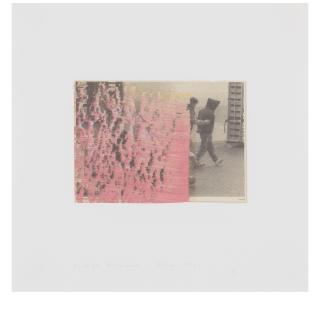Mimmo Paladino born 1948
The artist Mimmo Paladino
- Contemporary painter and important representatives of the Italian Transavantgarde.
- His style is characterized by mythological elements and a fresco-like technique.
- A visit to the Venice Biennale in his youth encouraged him to study art.
Domenico »Mimmo« Paladino is a contemporary Italian painter and object artist who is one of the few major representatives of the Italian Transavantgarde. He was born in 1948 in Paduli, a southern Italian town east of Naples. His uncle was the main source of his enthusiasm for art. He was a painter himself and introduced Paladino to various traditional techniques. A visit to the Venice Biennale (1964) was a key moment for the then 16-year-old to concentrate fully on art. From 1964 to 1968, Paladino studied painting at the Liceo Artistico in nearby Benevento, dabbling in collage, frottage, and abstract painting. He was inspired by artists such as Max Ernst and Paul Klee.
After his studies, around the mid-1970s, his style consolidated in the direction of mythological themes - he was particularly fond of the Icarus story. It was also during this period that Paladino developed the fresco technique that would later become so prominent. Shortly thereafter, in 1977, he had his first exhibition at the Lucio Amelio Gallery in Naples. At the end of the 1970s, the art critic Achille Bonito Oliva summarized Paladino's style and that of some other contemporaries under the term Transavanguardia.
The new decade began very successfully for the painter: in 1980 he participated in the Aperto 80 Biennale in Venice and in 1982 in the Sydney Biennale. Exhibitions at art houses such as the Kunstmuseum Basel and the Lenbachhaus in Munich followed. In 1999, he was elected an honorary member of the Royal Academy of Arts in London. Today, Paladino's works can be found in the collections of prominent museums such as the Tate Gallery in London, the Irish Museum of Modern Art (IMMA) in Dublin, the Metropolitan Museum of Art, and the Museum of Modern Art in New York.
Often working with pencil and mixed media on paper and wood, Paladino's mediums are primarily traditional. From watercolor and oil painting to tempera, collage, frottage, engraving, drypoint, and woodcut, he covers an extremely broad spectrum - he likes to leave the results untitled. Symbolic and mythical elements often find their way into his work. Paladino draws from sources such as ancient civilizations, mythical tales, and religious iconography. He simplifies their forms and limits himself to a restrained color palette. His works are usually balanced between figurative and abstract.
Der Künstler Mimmo Paladino
- Zeitgenössischer Maler und ein Hauptvertreter der italienischen Transavantgarde.
- Sein typischer Stil sind mythologische Elemente und eine freskenhafte Technik.
- Ein Besuch der Biennale von Venedig im Jugendalter animierte ihn zum Kunststudium.
Domenico »Mimmo« Paladino ist ein zeitgenössischer italienischer Maler und Objektkünstler, der zu den wenigen Hauptvertretern der italienischen Transavantgarde zählt. Er wurde 1948 in Paduli, einer süditalienischen Gemeinde östlich von Neapel, geboren. Für die Kunst begeistere ihn vor allem sein Onkel. Dieser war selbst Maler und brachte Paladino verschiedene traditionelle Techniken näher. Ein Besuch der Biennale von Venedig (1964) fungierte als Schlüsselmoment für den damals 16-Jährigen, sich voll und ganz auf die Kunst zu konzentrieren. Von 1964 bis 1968 studierte Paladino deshalb Malerei am Liceo Artistico im nahegelegenen Benevento und probierte sich bereits damals an Collagen, Frottagen und abstrakten Bildern. Künstler wie Max Ernst und Paul Klee inspirierten ihn dazu.
Nach seinem Studium, ab etwa Mitte der 1970er Jahre, festigte sich sein Stil in Richtung mythologischer Themen – besonders die Ikarus-Erzählung hatte es ihm angetan. Auch seine später so prominente Fresken-Technik entwickelte Paladino zu dieser Zeit weiter. Kurz darauf, im Jahr 1977, folgte seine erste Ausstellung – sie fand in der Galerie Lucio Amelio in Neapel statt. Ende der 1970er fasste der Kunstkritiker Achille Bonito Oliva Paladinos Stil und den einiger anderer Zeitgenossen unter dem Terminus der Transavanguardia zusammen.
Das neue Jahrzehnt begann gleich sehr erfolgreich für den Maler: 1980 nahm er an der Aperto 80 Biennale in Venedig, 1982 an der Biennale of Sydney teil. Es folgten Ausstellungen in Kunsthäusern wie dem Kunstmuseum Basel oder dem im Lenbachhaus in München. 1999 wählte ihn die Royal Academy of Arts in London außerdem zum Ehrenmitglied. Heute finden sich die Arbeiten von Paladino in den Sammlungen prominenter Museen wie etwa der Tate Gallery in London, dem Irish Museum of Modern Art (IMMA) in Dublin, dem Metropolitan Museum of Art und dem Museum of Modern Art in New York.
Paladino arbeitet oft mit dem Zeichenstift und setzt auf Mischtechniken auf Papier und Holz, er greift vorwiegend auf traditionelle Mittel zurück. Von Aquarell- und Ölmalerei über Tempera, Collagen, Frottagen, Gravuren, Kaltnadelradierungen bis hin zum Holzschnitt bedient er ein äußerst breitgefächertes Spektrum – die Ergebnisse belässt er gerne unbetitelt. Symbolische und mythische Elemente finden immer wieder Einzug in sein Werk. Paladino schöpft aus Quellen wie antiken Zivilisationen, mythischen Erzählungen und religiöser Ikonografie. Er vereinfacht ihre Formen und beschränkt sich auf eine zurückhaltende Farbpalette. Seine Werke balancieren meist zwischen figürlich und abstrakt.

















































